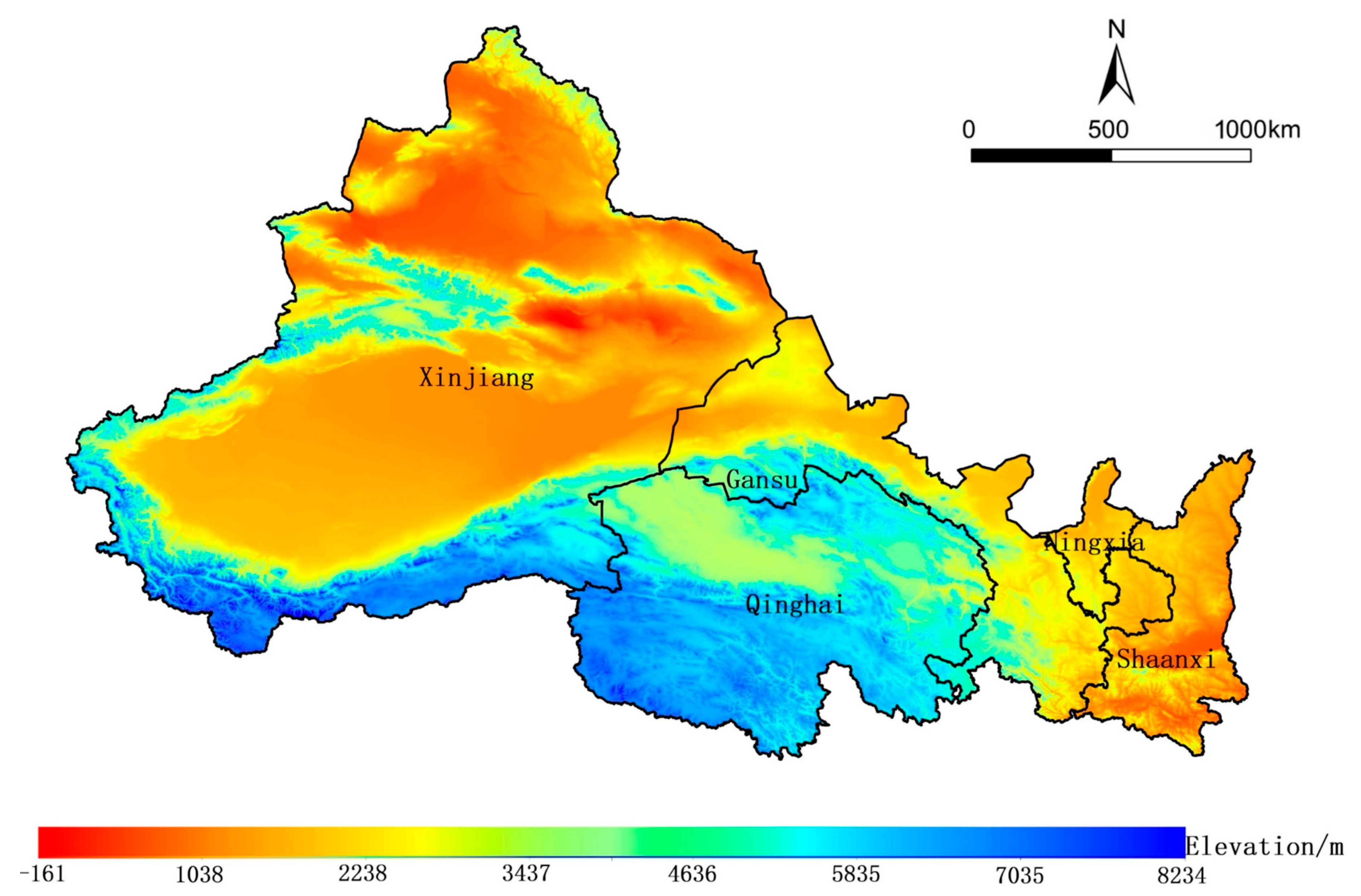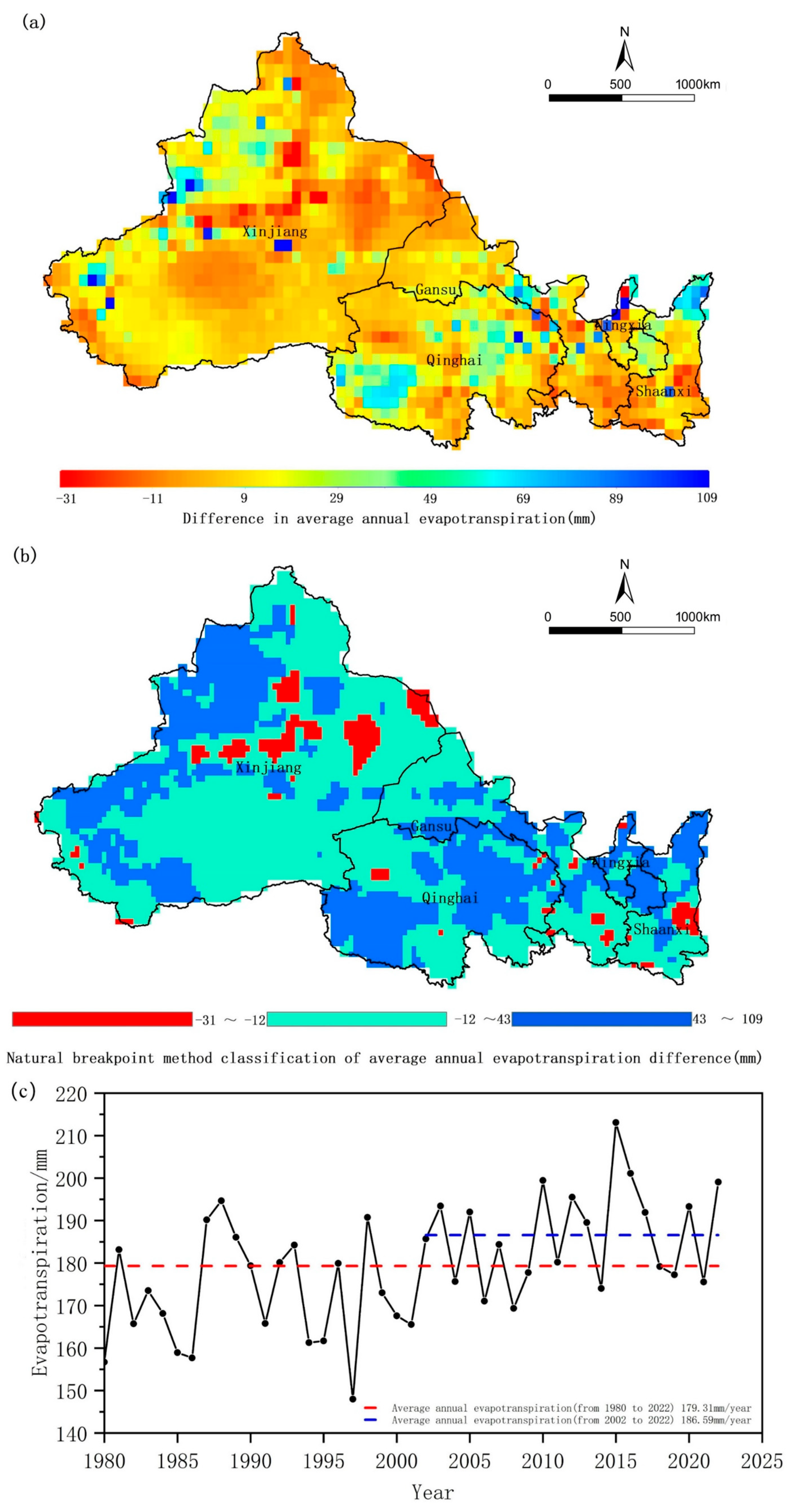Spatio-Temporal Changes of Terrestrial Water Storage in Five Provinces of Northwest China from 2002 to 2022 and Their Driving Factors
Abstract
1. Introduction
2. Data and Methods
2.1. Research Region
2.2. Data
2.2.1. GRACE Satellite Data
2.2.2. Monthly Precipitation Dataset
2.2.3. Runoff and Evapotranspiration Data
2.2.4. Actual Total Anthropogenic Water Consumption
2.3. Methods
- (1)
- GRACE/GRACE-FO Mascon solutions (Level-3 RL06) processed through an autoregressive moving average (ARMA) model to interpolate mission gaps (July 2017–May 2018), followed by Sen’s slope and Mann–Kendall trend analysis;
- (2)
- High-resolution precipitation data from the China Meteorological Science Data Center, spatially downscaled from station observations to a 0.25° grid via Kriging interpolation without in situ calibration;
- (3)
- The Kriging interpolation method for the evapotranspiration and runoff output of GLDA-NOAH v2.1;
- (4)
- Anthropogenic water consumption from WaterGAP v2.2d, regridded to 0.25°.

2.3.1. ARMA Model
2.3.2. Sen’s Slope Method and M-K Trend Tests
2.3.3. Water Balance Method
2.3.4. Natural Breakpoint Method
2.3.5. Quantification of Contributions
3. Results and Analysis
3.1. Spatio-Temporal Analysis of TWS Trends
3.2. Spatio-Temporal Analysis of Driving Factors
3.2.1. Precipitation
3.2.2. Evapotranspiration
3.2.3. Runoff
3.2.4. Anthropogenic Water Consumption
3.3. Quantification of Contributions of Driving Factors
4. Discussion
4.1. Evaluation of Causes for TWS Changes in Characteristic Regions
4.2. Evaluation of Contributions of Driving Factors
5. Conclusions
- (1)
- TWS in most areas of the five provinces of Northwest China showed a decreasing spatial pattern. The decreasing centers were mainly located at the center of the Xinjiang Uygur Autonomous Region and the Loess Plateau in the northern parts of Shaanxi Province and the Ningxia Hui Autonomous Region, while the enriching center is concentrated at the northern part of Qinghai–Tibet Plateau. With regard to the temporal pattern, the regional TWS demonstrated a periodically persistent and significantly decreasing trend, along with fluctuations, and the reduction rate per unit area in the research region was 2.86 mm/yr.
- (2)
- Precipitation responded consistently to the TWS change in spatial and temporal dimensions in the same time period. According to a water balance analysis, precipitation exerted a positive driving effect of 9.99 mm/yr over the years. Evapotranspiration responded to the spatial TWS change in the center of the Xinjiang Uygur Autonomous Region and the Loess Plateau in the northern parts of Shaanxi Province and the Ningxia Hui Autonomous Region, and its time series increased at 7.28 mm/yr over the years, so evapotranspiration became an important factor that dominated the reduction in WTS. Runoff was similar to evapotranspiration in terms of the spatial responses, and it increased at 7.09 mm/yr over the years, while the magnitude of the response of its time series was lower than that of precipitation and evapotranspiration. The time series of anthropogenic water consumption rose in a step-wise manner at 3.16 mm/yr, and anthropogenic water consumption is becoming an important factor for the change in TWS.
- (3)
- Precipitation positively and most greatly contributed to the TWS changes in most years. Runoff and evapotranspiration always had a negative contribution except for a few years; despite the lower contribution than the above factors, anthropogenic water consumption exhibited a stable negative contribution. The contribution rates of precipitation, evapotranspiration, runoff, and anthropogenic water consumption over the years were 0.363, −0.265, −0.258, and −0.115, respectively.
Author Contributions
Funding
Data Availability Statement
Conflicts of Interest
References
- Rodell, M.; Famiglietti, J.S.; Wiese, D.N.; Reager, J.T.; Beaudoing, H.K.; Landerer, F.W.; Lo, M.-H. Emerging trends in global freshwater availability. Nature 2018, 557, 651–659. [Google Scholar] [CrossRef] [PubMed]
- Ahamed, A.; Knight, R.; Alam, S.; Pauloo, R.; Melton, F. Assessing the utility of remote sensing data to accurately estimate changes in groundwater storage. Sci. Total Environ. 2022, 807, 150635. [Google Scholar] [CrossRef] [PubMed]
- Albarakat, R.; Le, M.-H.; Lakshmi, V. Assessment of drought conditions over Iraqi transboundary rivers using FLDAS and satellite datasets. J. Hydrol. Reg. Stud. 2022, 41, 101075. [Google Scholar] [CrossRef]
- Anyah, R.O.; Forootan, E.; Awange, J.L.; Khaki, M. Understanding linkages between global climate indices and terrestrial water storage changes over Africa using GRACE products. Sci. Total Environ. 2018, 635, 1405–1416. [Google Scholar] [CrossRef]
- Deng, H.; Chen, Y.; Chen, X. Driving factors and changes in components of terrestrial water storage in the endorheic Tibetan Plateau. J. Hydrol. 2022, 612, 128225. [Google Scholar] [CrossRef]
- Gao, G.; Zhao, J.; Wang, J.; Zhao, G.; Chen, J.; Li, Z. Spatiotemporal Variation and Driving Analysis of Groundwater in the Tibetan Plateau Based on GRACE Downscaling Data. Water 2022, 14, 3302. [Google Scholar] [CrossRef]
- Immerzeel, W.; Droogers, P.; de Jong, S.; Bierkens, M. Large-scale monitoring of snow cover and runoff simulation in Himalayan river basins using remote sensing. Remote Sens. Environ. 2009, 113, 40–49. [Google Scholar] [CrossRef]
- Jing, W.; Zhao, X.; Yao, L.; Jiang, H.; Xu, J.; Yang, J.; Li, Y. Variations in terrestrial water storage in the Lancang-Mekong river basin from GRACE solutions and land surface model. J. Hydrol. 2020, 580, 124258. [Google Scholar] [CrossRef]
- Neves, M.C.; Nunes, L.M.; Monteiro, J.P. Evaluation of GRACE data for water resource management in Iberia: A case study of groundwater storage monitoring in the Algarve region. J. Hydrol. Reg. Stud. 2020, 32, 100734. [Google Scholar] [CrossRef]
- Schmied, H.M.; Cáceres, D.; Eisner, S.; Flörke, M.; Herbert, C.; Niemann, C.; Peiris, T.A.; Popat, E.; Portmann, F.T.; Reinecke, R.; et al. The global water resources and use model WaterGAP v2.2d: Model description and evaluation. Geosci. Model Dev. 2021, 14, 1037–1079. [Google Scholar] [CrossRef]
- Panday, D.P.; Kumar, M. Application of remote sensing techniques to deal with scale aspects of GRACE data to quantify groundwater levels. MethodsX 2023, 10, 102108. [Google Scholar] [CrossRef] [PubMed]
- Tucker, C.J. Remote sensing of leaf water content in the near infrared. Remote Sens. Environ. 1980, 10, 23–32. [Google Scholar] [CrossRef]
- Ying, M. Research on the Impact of Climate Change and Human Activities on the Variation of Land Water Storage in China. J. North China Univ. Water Resour. Electr. Power 2021, 42, 47–57. [Google Scholar]
- Xiang, L.; Wang, H.; Steffen, H.; Jiang, L.; Shen, Q.; Jia, L.; Su, Z.; Wang, W.; Deng, F.; Qiao, B.; et al. Two Decades of Terrestrial Water Storage Changes in the Tibetan Plateau and Its Surroundings Revealed through GRACE/GRACE-FO. Remote Sens. 2023, 15, 3505. [Google Scholar] [CrossRef]
- Xiao, C.; Zhong, Y.; Feng, W.; Gao, W.; Wang, Z.; Zhong, M.; Ji, B. Monitoring the Catastrophic Flood With GRACE-FO and Near-Real-Time Precipitation Data in Northern Henan Province of China in July 2021. IEEE J. Sel. Top. Appl. Earth Obs. Remote Sens. 2022, 16, 89–101. [Google Scholar] [CrossRef]
- Guo, R.J.; Wang, H.J.; Cai, A.N.; Nan, J.N.; Zhang, L.L. Analysis of temporal and spatial changes of China terrestrial water storage under the background of gravity satellites. J. Tianjin Norm. Univ. (Nat. Sci. Ed.) 2022, 42, 43–52. [Google Scholar]
- Mo, X.; Wu, J.J.; Wang, Q.; Zhou, H.J. Variations in water storage in China over recent decades from GRACE observations and GLDAS. Nat. Hazards Earth Syst. Sci. 2016, 16, 469–482. [Google Scholar] [CrossRef]
- Chen, Y.N.; Yi, L. Ponder on the issues of water resources in the arid region of northwest China. Arid. Land Geogr. 2012, 35, 1–9. [Google Scholar]
- Zhang, P.; Chen, X.; Bao, A.; Liu, T.; Ndayisaba, F. Assessing spatio-temporal characteristics of water storage changes in the mountainous areas of Central Asia based on GRACE. Chin. Geogr. Sci. 2017, 27, 918–933. [Google Scholar] [CrossRef]
- Cheng, S.; Yu, H.; Ren, Y. Research progress on the mechanism of abnormal climate impact in arid and semi-arid regions of China. Chin. Desert 2023, 43, 21–35. [Google Scholar]
- Ding, H.; Shi, X.; Wu, M. Inversion of Land Water Storage Changes in the Yellow River Basin Based on GRACE Gravity Data. J. Water Resour. Water Eng. 2021, 32, 109–115. [Google Scholar]
- Du, X.; He, L.; Ren, S. The evolution of water resources and changes in water supply composition in northern China. J. Jilin Univ. Earth Sci. Ed. 2023, 53, 566–577. [Google Scholar]
- Huang, M. Research on Flood Disaster Monitoring and Prediction in Shouguang City Based on Seminel-1/2 Data. Ph.D. Thesis, Nanjing University of Information Science and Technology, Nanjing, China, 2022. [Google Scholar]
- Xu, P.; Jiang, T.; Zhang, C.; Rui, M.; Liu, Y. Data filling of terrestrial water storage anomaly during the gap period of GRACE/GRACE-FO: A case study of global typical basins. Chin. J. Geophys. 2021, 64, 3048–3067. [Google Scholar] [CrossRef]
- Lu, D.; Yan, L.; Xu, Y. Extreme precipitation trend analysis in the Beijing Tianjin Hebei region based on multiple trend analysis methods. Yellow River 2022, 44, 26–32. [Google Scholar]
- Lu, X. Analysis of Land Water Storage Changes and Potential Environmental Effects in the Yellow River Basin Based on GRACE Gravity Satellite. Master’s Thesis, China University of Mining and Technology, Beijing, China, 2022. [Google Scholar]
- Nie, S.; Li, W.; Zheng, W. Analysis of changes in land water storage in the Haihe River Basin before and after the South to North Water Diversion Project. Geod. Geodyn. 2023, 43, 128–134. [Google Scholar]
- Cai, Y.; Cao, S.; Du, M. Estimation of total anthropogenic heat in prefecture level cities in China and analysis of driving factors. J. Earth Inf. Sci. 2021, 23, 405–418. [Google Scholar]
- Shi, S. A Study on the Spatiotemporal Evolution of Ecological Environment Vulnerability in the Five Northwestern Provinces. Master’s Thesis, Northwest Normal University, Lanzhou, China, 2019. [Google Scholar]
- Wang, R.; Li, Z. Characteristics of water regime evolution in Poyang Lake over the past 60 years. Trop. Geogr. 2017, 37, 512–521. [Google Scholar]
- Zhang, Q.; Yang, J.; Ma, P.; Yue, P. The characteristics and formation mechanism of enhanced eastward expansion of climate warming and humidification in the northwest region and its important environmental impacts. Arid. Meteorol. 2023, 41, 351–358. [Google Scholar]
- Sun, W.; Jin, Y.; Yu, J.; Wang, G.; Xue, B.; Zhao, Y.; Fu, Y.; Shrestha, S. Integrating satellite observations and human water use data to estimate changes in key components of terrestrial water storage in a semi-arid region of North China. Sci. Total Environ. 2020, 698, 134171. [Google Scholar] [CrossRef]
- Yi, H.; Wen, L. Satellite gravity measurement monitoring terrestrial water storage change and drought in the continental United States. Sci. Rep. 2016, 6, 19909. [Google Scholar] [CrossRef]







Disclaimer/Publisher’s Note: The statements, opinions and data contained in all publications are solely those of the individual author(s) and contributor(s) and not of MDPI and/or the editor(s). MDPI and/or the editor(s) disclaim responsibility for any injury to people or property resulting from any ideas, methods, instructions or products referred to in the content. |
© 2025 by the authors. Licensee MDPI, Basel, Switzerland. This article is an open access article distributed under the terms and conditions of the Creative Commons Attribution (CC BY) license (https://creativecommons.org/licenses/by/4.0/).
Share and Cite
Li, A.; Wu, Z.; Yin, M.; Guo, Z. Spatio-Temporal Changes of Terrestrial Water Storage in Five Provinces of Northwest China from 2002 to 2022 and Their Driving Factors. Water 2025, 17, 1417. https://doi.org/10.3390/w17101417
Li A, Wu Z, Yin M, Guo Z. Spatio-Temporal Changes of Terrestrial Water Storage in Five Provinces of Northwest China from 2002 to 2022 and Their Driving Factors. Water. 2025; 17(10):1417. https://doi.org/10.3390/w17101417
Chicago/Turabian StyleLi, Aimin, Zekun Wu, Meng Yin, and Zhenqiang Guo. 2025. "Spatio-Temporal Changes of Terrestrial Water Storage in Five Provinces of Northwest China from 2002 to 2022 and Their Driving Factors" Water 17, no. 10: 1417. https://doi.org/10.3390/w17101417
APA StyleLi, A., Wu, Z., Yin, M., & Guo, Z. (2025). Spatio-Temporal Changes of Terrestrial Water Storage in Five Provinces of Northwest China from 2002 to 2022 and Their Driving Factors. Water, 17(10), 1417. https://doi.org/10.3390/w17101417





